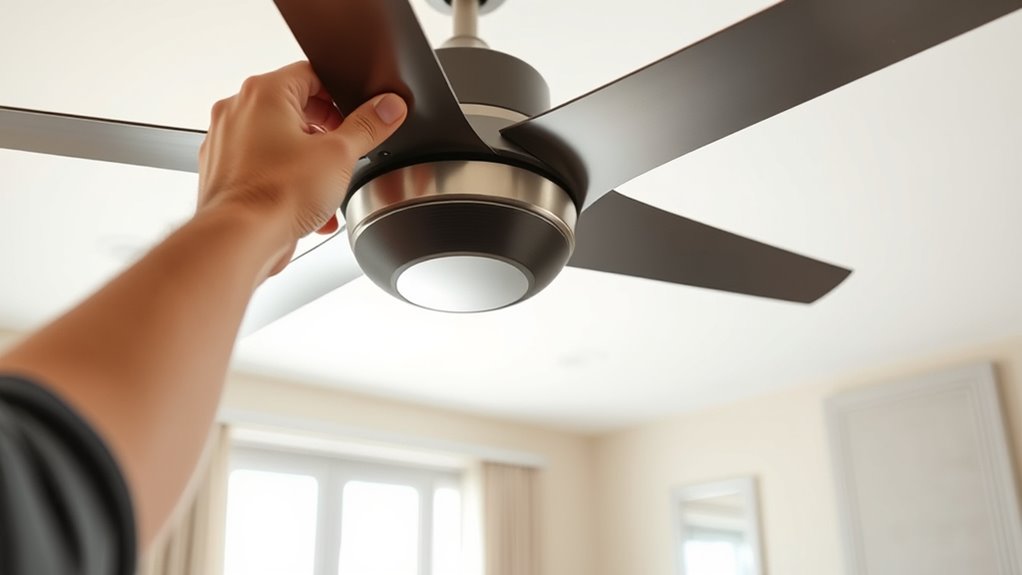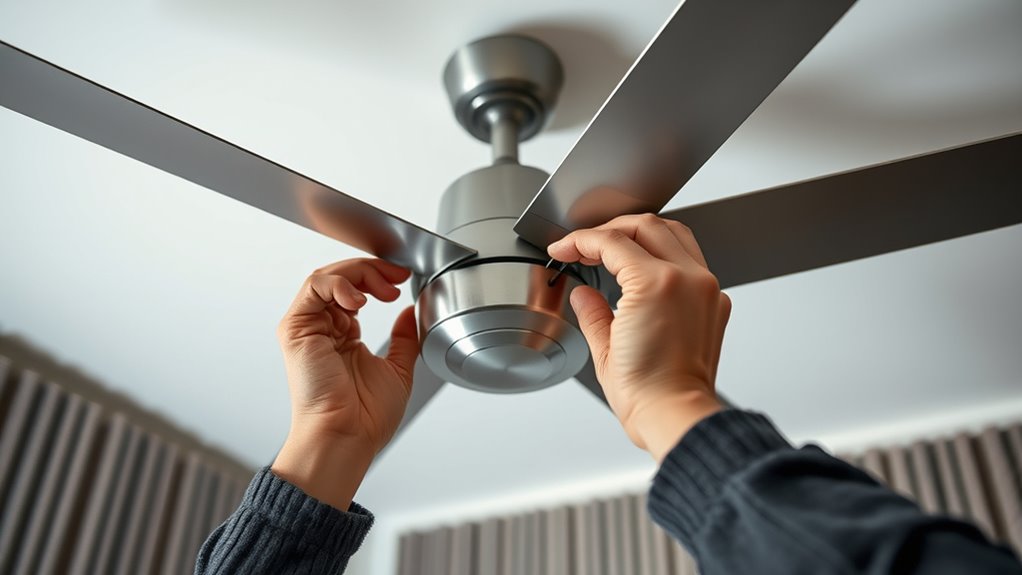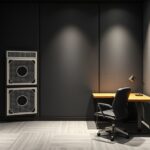To silence fan noise in quiet rooms, start by cleaning vents and filters to improve airflow and reduce the strain on your fan. Adjust the fan speed to lower settings and tighten any loose parts or blades to minimize vibrations. Adding sound-absorbing materials around the fan and mounting it on vibration-isolating pads can considerably dampen noise. For even quieter operation, consider upgrading to a fan designed for silence—stick around for more tips to achieve ideal quietness.
Key Takeaways
- Clean vents and filters regularly to prevent airflow restrictions that increase noise.
- Use vibration dampening mounts or pads to reduce mechanical vibrations from fans.
- Adjust fan speed settings to operate at lower, quieter levels without sacrificing airflow.
- Add sound-absorbing materials like foam or acoustic panels around the fan for quieter operation.
- Inspect and replace worn or unbalanced blades and lubricate motors for smoother, quieter functioning.

Fan noise can be disruptive, but fixing it is often straightforward. If you’re dealing with a noisy fan in a quiet room, your first step is to consider airflow optimization. When airflow is restricted or uneven, the fan has to work harder, generating more noise. Check that your vents and filters are clean and unobstructed. Clear out any dust buildup that might be blocking airflow, and ensure that the fan isn’t placed too close to walls or furniture that could cause turbulence or echo. Proper airflow not only reduces strain on the fan but also minimizes vibrations that contribute to noise. You can also experiment with repositioning the fan for better airflow paths, avoiding tight corners or confined spaces that cause turbulence. Adjusting fan speed settings, if available, can also help, since running the fan at a lower speed often produces less noise without sacrificing performance. Additionally, regular maintenance, such as tightening loose screws or replacing worn components, can prevent additional noise caused by mechanical issues.
Optimizing airflow and repositioning your fan can significantly reduce noise and improve performance.
Alongside airflow optimization, noise dampening techniques play a vital role in quieting fan noise. You can add materials that absorb sound around the fan, such as foam padding or acoustic panels, especially if the fan is housed inside a cabinet or enclosed space. Placing rubber or silicone mounts between the fan and its housing can dampen vibrations that typically amplify noise. Sometimes, the fan blades themselves are the culprit; worn or bent blades create irregular vibrations and sounds. Replacing or balancing the blades can notably cut down on noise levels. Using vibration isolation mounts for the entire fan assembly can also help prevent vibrations from transmitting into walls or furniture, reducing overall noise pollution in your room. Ensuring the fan operates smoothly through proper lubrication and part replacement can further decrease noise levels.
Additionally, inspecting the motor and bearings can uncover underlying issues. Worn-out bearings often cause grinding or squealing sounds. Lubricating the motor and replacing worn bearings can restore smooth operation and reduce noise. If noise persists despite these measures, consider upgrading to a quieter fan model designed with noise dampening features. Modern fans often incorporate sound-absorbing materials and aerodynamic blade designs that cut down on unwanted noise without sacrificing airflow efficiency. Choosing a fan with noise reduction features can be a worthwhile investment for maintaining a peaceful environment.
Ultimately, a combination of airflow optimization and noise dampening techniques can make a notable difference. By ensuring your fan operates efficiently with unobstructed airflow and applying sound-absorbing solutions, you’ll create a more peaceful environment. Quiet rooms depend on reducing these disturbances, and addressing fan noise with simple yet effective adjustments can restore tranquility without the need for complex or costly solutions.
Frequently Asked Questions
Can Replacing the Fan Reduce Noise Effectively?
Replacing the fan can considerably reduce noise, especially if you choose a quieter model. By selecting a fan with adjustable fan speed, you can lower the noise level during less demanding times. Additionally, optimizing airflow with the new fan helps decrease strain, which often causes louder operation. Overall, a new fan designed for quiet operation, combined with controlling fan speed and airflow, effectively minimizes noise in your room.
Are There Specific Fan Models Known for Quieter Operation?
Did you know some fans operate at noise levels below 20 decibels? You should look for models with silent blades and vibration dampening features, as these substantially reduce noise. Brands like Dyson and Minka-Aire are known for quieter operation, often incorporating advanced technology to minimize sound. Choosing a fan with these features guarantees a more peaceful environment, especially if you’re sensitive to noise or need quiet for work or sleep.
How Often Should Fans Be Cleaned to Prevent Noise?
You should clean your fans every 1 to 3 months to prevent noise caused by dust buildup. Regular cleaning keeps dust from accumulating on blades and motor parts, which can cause the fan to work harder and become louder. Follow a consistent cleaning schedule, especially if you notice increased noise or reduced airflow. Using a soft cloth or brush, gently remove dust to keep your fan running quietly and efficiently.
Does Room Size Influence the Type of Fan Needed?
Yes, room size influences the type of fan you need. Larger rooms need more powerful fans or multiple units to improve airflow, but you should also consider room acoustics to minimize noise. Proper fan placement is key; position fans away from walls and corners to reduce sound reflection and noise. Selecting the right size and placement helps maintain a quiet environment while ensuring efficient cooling or air circulation.
Are Noise-Canceling Devices Effective Against Fan Sounds?
Think of noise-canceling devices as your shield against unwelcome fan sounds. They’re quite effective, especially when combined with soundproofing techniques that lower ambient noise levels. While they won’t eliminate every hum, these gadgets actively reduce noise, making your space more peaceful. You’ll find that with the right setup, fan noise becomes less intrusive, transforming your quiet room into a true sanctuary of calm and serenity.
Conclusion
Think of your quiet room as a sanctuary, where peace should flow effortlessly. When fan noise disrupts that harmony, it’s like a crack in the calm surface, threatening serenity. But with a few simple fixes, you can restore the stillness, letting the gentle hum of comfort wash over you once more. Remember, silence isn’t just absence of sound—it’s a refuge where your mind can breathe freely, restored and renewed.














